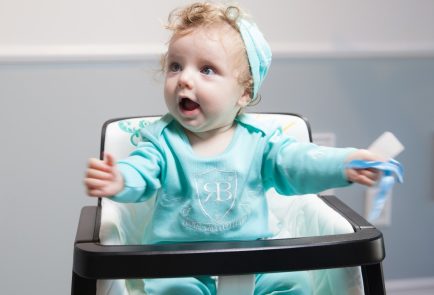Of the many things that our body has, a belly button is one that often intrigues us. The navel, belly button, or umbilicus is formed when the umbilical cord of the baby is cut and clamped immediately after his birth. This cord dries and falls within a few days and a navel forms in that place.
Babies can have an innie or outie belly button. While a majority of babies have an innie, 10-20% have an outie umbilicus. MomJunction tells you how an outie is caused, if it is normal, and what needs to be done to take care of the belly button.
What Is An Outie Belly Button?
An outie belly button is the one that protrudes. Usually, the belly button moves inside and is called an innie.
An outie looks like a tiny balloon. It blows out when the baby is crying, laughing, coughing, or has bowel movements. This is because of the increased pressure from inside the abdomen. It shrinks when the baby is relaxing.
Why Does Your Newborn Have An Outie Belly Button?
Outies are usually caused due to two reasons:
- A common reason for an outie belly button is an umbilical hernia .
- A granulation tissue is formed at the umbilicus resulting in excess loose skin at the region.
- Outie Due To Umbilical Hernia:
- The umbilical hernia is formed due to weak spots in the muscle wall around the abdomen of the baby.
- Inside the mother’s womb, the umbilical cord connects through the baby’s abdomen. Once the baby comes out and the cord is cut, an opening is formed at the place, which gets sealed with the help of the muscles.
- In some cases, the muscles don’t seal it completely, creating a small hole. Hernia occurs when a part of the intestine bulges into this hole.
- It is common in girls, premature babies, and African-Americans. (umbilical hernia)
Symptoms Of Serious Umbilical Hernia:
- Hernia is usually harmless, and your baby will not have any pain.
- However, in rare cases, the intestine gets stuck in the hole. If you notice these symptoms, take your baby to a doctor immediately:
- Pain around the belly button
- Change in the color around the hernia
- Swelling in the region
- Vomiting
- Fever
When Does A Baby’s Belly Button Go In?
An outie cannot become an innie but it does go in once the muscles in the abdomen grow stronger and the hole gets healed by itself. The hole usually closes within 12 to 18 months but takes longer if it is bigger.
Irrespective of the size, the hernia closes by the time the child turns five years.
Surgery is required if:
- the hole does not close by the age of five.
- the intestine is stuck in the hole.
- the hernia is growing bigger as the child grows.
- The surgery is a simple procedure that takes around 20 to 30 minutes. The doctor will make a small incision at the umbilicus and push the protruded part/tissue inside. He will then stitch together the opening in the abdomen wall. The procedure is done under general anesthesia.
Your baby’s belly button needs to be dry and free of any infection. Here is how you can take care of the area:
- Keep the base dry because a drier cord falls sooner than a wet one.
- Clean the base of the cord with a cotton swab every time you change your baby’s nappy.
- Do not cover the area with the nappy. Fold the nappy down.
- Covering up the cord with the nappy could result in infection due to lack of air circulation and the baby’s urine.
- Earlier, paediatricians used to suggest cleaning of the region with alcohol, but the practice is not being encouraged now.
- Never try to remove the cord forcefully. Let it fall off naturally.
- Use a mild soap to clean the area. Ask your doctor to recommend a suitable soap.
- Give a sponge bath to your baby in the initial days to avoid wetting the cord.
The belly button of your baby could be infected if :
- yellow or white pus oozes from it.
- the base is red or swollen.
- the cord is bleeding.
- there is pain in the navel.
- Signs of infection of the umbilical cord stump could result in a life-threatening infection called omphalitis. This is a serious condition, which needs to be treated immediately.
When Should You Call The Doctor?
Watch out for these signs of infection and call your pediatrician immediately:
- Foul smell from the area
- Yellow sticky discharge from the area
- Swelling, tenderness or redness in the skin around the area
- High fever
- Weakness or excessive drowsiness
- Not interested in being fed or feeding very little
- Skin appears to look saggy and floppy around the area
- Can I Change My Baby’s Belly Button To Be Outie Or Innie?
No, you cannot make your baby’s belly button an outie or innie. Not even the obstetrician can do it for you as the formation is natural.
Contrary to popular belief, an outie is not formed due to the faulty cutting or clamping of the cord.
- Does Pressing A Coin Push The Belly Button Inside?
The practice of taping a coin on the belly button is prevalent among various cultures to push it inside. However, it does not help the navel in going in.
Moreover, it could be a health hazard if the germs on the coin pass on to the baby.
Also, never try to press back the belly button of your newborn. It may be soft but will not go inside if you push it. In fact, the pressure could harm the baby’s abdomen.
- Can I Prevent An Outie Belly Button?
No, you cannot prevent an outie as it is not a condition or a faulty development. An outie navel is as natural as an innie.
- How Can I Clean My Baby’s Outie Belly Button?
You can clean your baby’s outie with a washcloth and soap.
- What Is Umbilical Granuloma?
An umbilical granuloma is the overgrowth of tissue when the cord is healing. It is light pink in color and has a yellow discharge. However, this is different from an infection as it is not accompanied by a fever, odor, or swelling.
- Can I Treat Minor Belly Button Infection At Home?
Yes, you can treat navel infections at home as long as they are not serious.
If there is a discharge in the belly button, clean the area twice a day with cotton swab or cloth.
Use an antibiotic ointment such as Polysporin twice a day if pus is oozing from the area.
In the case of slight bleeding, clean the area and press the navel with a clean cloth for ten minutes to stop the flow. If it does not stop, visit a doctor.
Your newborn’s outie belly button is a perfectly natural and normal condition. Speak to your pediatrician about it to know more and prevent any infection.
Original article: https://www.momjunction.com/articles/why-does-your-newborn-have-an-outie-belly-button_00330241/































Comments